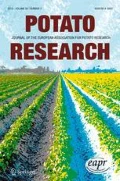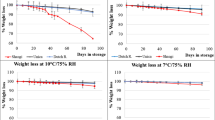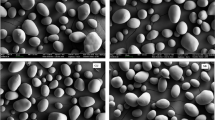Summary
Potato tubers of several Polish varieties and strains were stored at low temperature (1, 2 and 6°C) and examined for sugar accumulation. The amount of accumulated sugar depended on the variety (strain) and was negligible at 6°C, greater at 2°C and the greatest at 1°C. The reducing sugar usually predominated and fructose was accumulated faster than glucose. There were two exceptions (R-42431 and R-38319), which accumulated a high percentage of sucrose with an accompanying low percentage of reducing sugars.
Zusammenfassung
Kartoffelknollen einiger polnischen Sorten und Stämme wurden während 18 oder 22 Wochen bei Temperaturen von 1, 2 und 6° C gelagert. Nach der Lagerung wurden die Gehalte an Gesamtzucker, reduzierenden Zuckern, Saccharose, Glukose und Fruktose bestimmt. Die Ergebnisse der Zuckeranhäufung bei 1°C wurden mit jenen in der amerikanischen Sorte Kennebec verglichen, die unter den gleichen Bedingungen aufbewahrt wurde.
Zuckeranhäufung bei verschiedenen Sorten und Stämmen unterscheidet sich sowohl quantitativ wie qualitativ. Eine temperatur von 6° C dürfte im allgemeinen den Gesamtzuckergehalt nicht wesentlich verändern; bei einigen Sorten ist dies aber doch der Fall (Abb. 1 und 2). Die Anhäufung reduzierender Zucker bei dieser Temperatur wird vor allem durch den Abbau der Saccharose verursacht, die während der Lagerung abnimmt (Abb. 3 und 5). Temperaturen von 2 und 1° C steigern die Zuckeranhäufung stark. Eine Temperatur von 2°C beschleunigt hauptsächlich die Anhäufung reduzierender Zucker mit relativ geringer Anhäufung von Saccharose, während eine Temperatur von 1°C sowohl die Menge an reduzierenden Zuckern als auch an Saccharose ändert (Abb. 1–6). Der Gesamtzuckergehalt war infolge der rascheren Saccharose-Anhäufung in einer Periode während der Lagerung bei 1°C in verschiedenen Lagerperioden unterschiedlich (Abb. 1 und 5), während der Gehalt an reduzierenden Zuckern gleich blieb (Abb. 3). Das heisst, dass die Reaktion von Kartoffelknollen auf Zuckeranhäufung bei tiefen Temperaturen unter anderem von der vorangehenden Wachstumsperiode abhängt.
Die Knollen der untersuchten Sorten und Stämme zeigten eher ein niedriges Verhältnis Saccharose/reduzierende Zucker (Tab. 1). Sogar die amerikanische Kontrollsorte Kennebec ergab ein ganz niedriges Verhältnis von 0,36. Dies kann durch den Einfluss von geographischen Bedingungen während des Kartoffelwachstums in Polen erklärt werden.
Das unterschiedliche Verhältnis Glukose/Fruktose in Mustern vor und nach der Lagerung kann aus Tabelle 2 ersehen werden. Der vorherrschende Zucker in der Kontrolle ist Glukose, während tiefe Temperaturen die Fruktose-Anhäufung begünstigen.
Die gegenwärtigen Versuche zeigten, dass die Reaktion von Knollen auf tiefe Lagertemperaturen ein Sortenmermal ist. Gewisse Sorten (Stämme) häufen in der Regel geringe Zuckermengen an, wie zum Beispiel die Sorte Nina (Abb. 2, 4 und 6), während andere Sorten rasch Zucker anhäufen, wie zum Beispiel Flisak. Diese Feststellung ist vom technologischen Standpunkt aus wichtig.
Zwei Stämme, R-42431 und R-38318, wurden in ihrer Zuckeranhäufung bei tiefer Temperatur als atypisch befunden. Diese Stämme reichern während der Lagerung bei 1°C sehr grosse Mengen Saccharose an, während die reduzierenden Zucker auf einem sehr tiefen Stand bleiben (Abb. 4 und 6).
Résumé
Des tubercules de pomme de terre de divers variétés et hybrides polonais ont été conservés à des températures de 1, 2 et 6°C pendant 18 à 22 semaines. Les sucres totaux, les sucres réducteurs, le saccharose, les glucose et fructose ont fait l'object de déterminations après la conservation. Les résultats de l'accumulation de sucres à 1°C sont comparés à ceux de la variété américaine Kennebec conservée dans les mêmes conditions.
L'accumulation de sucres dans les différents variétés et hybrides varie à la fois sur les plans quantitatif et qualitatif. Une température de 6°C peut ne pas modifier sensiblement la quantité totale des sucres, quoique ce soit le cas chez quelques variétés (fig. 1 et 2). A cette température, l'accumulation des sucres réducteurs est due en tout premier lieu à la décomposition du saccharose, dont la quantité diminue pendant la conservation (fig. 3 et 5). Des températures de 2 et 1°C élèvent considérablement l'accumulation des sucres. Une température de 2°C accélère principalement l'accumulation des sucres réducteurs et relativement peu l'accumulation du saccharose; par contre une température de 1°C modifie aussi bien les quantités de sucres réducteurs que de saccharose (fig. 1–6). La quantité totale de sucres varie au cours d'une conservation à 1°C avec les périodes de conservation parce que l'accumulation de sucrose est plus rapide pendant une période (fig. 1 et 5), alors que les sucres réducteurs restent au même niveau (fig. 3). Ce qui signifie que la réaction des tubercules de pomme de terre à l'accumulation de sucres à basse température dépend, parmi d'autres facteurs, des périodes précédentes de croissance.
Les tubercules des variétés et hybrides examinés ont montré un rapport saccharose/sucres réducteurs plutôt bas (tableau 1). Même chez la variété américaine de référence Kennebec, le rapport était tout à fait bas: 0,36. Ceci peut s'expliquer par l'influence de conditions géographiques au cours de la croissance des pommes de terre en Pologne.
On peut voir dans le tableau 2 les différents rapports glucose/fructose dans les échantillons avant et après le stockage. Le sucre le plus abondant dans les contrôles est le glucose fandis que la basse température favorise l'accumulation de fructose.
Les présentes expériences ont montré que la réaction des tubercules à basse température de conservation présente un aspect variétal. Certaines variétés (hybrides) accumulent régulièrement de faibles quantités de sucres comme par exemple, la variété Nina (fig. 2, 4 et 6), alors que d'autres en produisent rapidement, telle Flisak. Ce fait est important du point de vue technologique.
Deux hybrides, R-42431 et R-38319, se révèlent atypiques pour leur accumulation de sucres à basse température. Ils accumulent de très grosses quantités de sucrose à une conservation à 1°C, alors que les sucres réducteurs se maintiennent à un niveau très bas (fig. 4 et 6).
Similar content being viewed by others
References
Appleman, C. 1915. Physiological behavior of enzymes and carbohydrates transformation in afterripening of the potato tuber.Bot. Gaz. 52: 306.
Arreguin-Lozano, B. & J. Bonner, 1949. Experiments on sucrose formation by potato tubers as influenced by temperature.Pl. Physiol. 24: 720–738.
Burton, W. G., 1969. The sugar balance in some British potato varieties during storage. II. The effects of tuber age, previous storage temperature, and intermittent refrigeration upon low-temperature sweetening.Eur. Potato J. 12: 81–95.
Denny, F. & N. Thornton, 1942. The third years' results on storage of potato tubers in relation to sugar content and color of potato chips.Centr. Royce Thomps. Inst., 12: 405.
Pressey, R. & R. Shaw, 1966. Effect of temperature on intvertase, invertase inhibitor and sugars in potato tubers.Pl. Physiol. 41: 1657–1661.
Røsen, K. & S. Frogner, 1969. The influence of storage and conditioning on the content of reducing sugars in potatoes grown in Norway.Eur. Potato J. 12: 122–133.
Prokoshev, S. M. & N. Mattison, 1949. Biochemical characteristic of new potato varieties.Vest. soc. past. 4: 51.
Samotus, B., Z. Kolodziej, M. Niedźwiedź, M. Leja & B. Czajkowska, 1973. Some aspects of total losses during storage and reconditioning of potato tubers.Potato Res. 16: 61–67.
Samotus, B. & M. Kujawski, 1969. The application of dinitrophenol and anthrone for the determination of sugar content in potato tuber juice (Polish: English summary).Roczniki technol. chem. Zywności 15: 5–16.
Samotus, B., M. Niedźwiedź & Z. Kolodziej, 1969a. Rapid determination of soluble constituents of potato tuber by means of sap analysis (Polish: English summary).Biul. Inst. Ziemniaka 4: 73–86.
Samotus, B., M. Niedźwiedź & Z. Kolodziej 1969b. Refractometric determination of changes in sugar content in stored and reconditioned potato tubers (Polish: English summary).Biul. Inst. Ziemniaka 4: 87–97.
Samotus, B. & S. Schwimmer, 1962. Predominance of fructose accumulation in cold-stored immature potato tubers.J. Food Sci. 27: 1–4.
Author information
Authors and Affiliations
Rights and permissions
About this article
Cite this article
Samotus, B., Niedźwiedź, M., Kolodziej, Z. et al. Storage and reconditioning of tubers of Polish potato varieties and strains. 1. influence of storage temperature on sugar level in potato tubers of different varieties and strains. Potato Res 17, 64–81 (1974). https://doi.org/10.1007/BF02361870
Accepted:
Issue Date:
DOI: https://doi.org/10.1007/BF02361870




